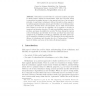Free Online Productivity Tools
i2Speak
i2Symbol
i2OCR
iTex2Img
iWeb2Print
iWeb2Shot
i2Type
iPdf2Split
iPdf2Merge
i2Bopomofo
i2Arabic
i2Style
i2Image
i2PDF
iLatex2Rtf
Sci2ools
ESORICS
2004
Springer
2004
Springer
Redundancy and Diversity in Security
Redundancy and diversity are commonly applied principles for fault tolerance against accidental faults. Their use in security, which is attracting increasing interest, is less general and less of an accepted principle. In particular, redundancy without diversity is often argued to be useless against systematic attack, and diversity to be of dubious value. This paper discusses their roles and limits, and to what extent lessons from research on their use for reliability can be applied to security, in areas such as intrusion detection. We take a probabilistic approach to the problem, and argue its validity for security. We then discuss the various roles of redundancy and diversity for security, and show that some basic insights from probabilistic modelling in reliability and safety indeed apply to examples of design for security. We discuss the factors affecting the efficacy of redundancy and diversity, the role of “independence” between layers of defense, and some of the trade-offs...
Accidental Faults | ESORICS 2004 | Fault Tolerance | Security Privacy | Trade-offs Facing Designers |
Related Content
| Added | 01 Jul 2010 |
| Updated | 01 Jul 2010 |
| Type | Conference |
| Year | 2004 |
| Where | ESORICS |
| Authors | Bev Littlewood, Lorenzo Strigini |
Comments (0)

